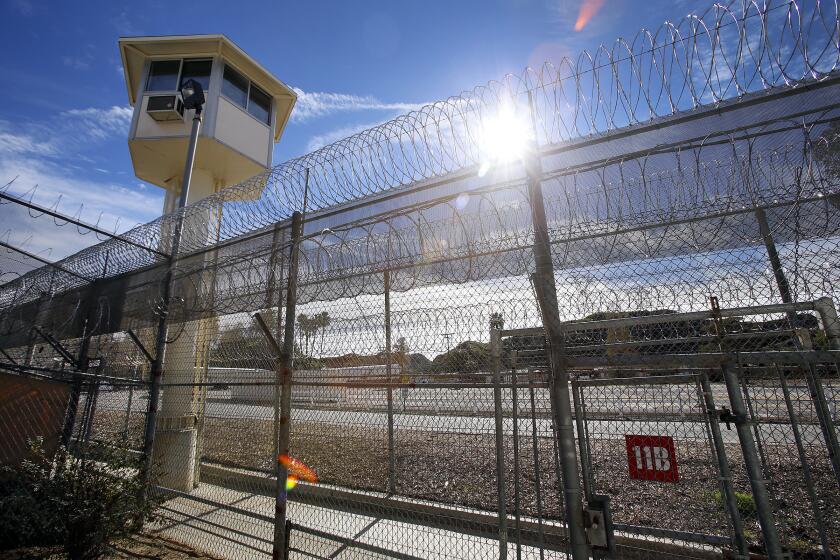The possibility of death is never far from the mind of a California highway worker.
- Share via
Asign is posted prominently inside the musty shed at the Caltrans yard in Newhall.
“Please Don’t Smoke,” it reads, taking up the oft-heard anti-smoking cry of modern American life, “We’d rather die of natural causes.”
The possibility of death is never far from the mind of a California highway worker these days. Forty-five have been killed since 1972, 24 by errant motorists, making their job more potentially lethal than that of California Highway Patrol officers, 40 of whom have been killed in the same period.
Last Dec. 12, 36-year-old Henry Mendoza, who had worked in the Newhall office, was killed while setting up highway cones between the Glendale and Foothill freeways in Glendale. A car drove through the cones and hit a Caltrans trailer, which hit Mendoza. More than 150 of Mendoza’s colleagues, dressed in their distinctive orange vests, attended the funeral.
“He was a good worker,” recalled Roger Moody, a Newhall supervisor and Mendoza’s close friend. But Mendoza, in his opinion, made a mistake by going to work setting out the cones before the heavy equipment arrived, which would have been parked in front of the workers to protect them. “They didn’t wait for backup,” Moody said.
On a recent morning, Moody and his 10-man crew were confronting a job that would have been rough, grueling work on a normal construction site: replacing a 10-foot-square, 10-inch-thick slab of concrete that looked like it could hold back the Colorado River. But this slab was lying in the right-hand lane of Interstate 5, a wide expanse of highway amid open canyons that encourages reckless speed.
Moody, mustachioed, 50 years old and regarded by colleagues as “hard but fair,” had been watching cracks grow in the slab for months. Now, as the big semitrailers roared deafeningly by, accelerating as they descended Weldon Grade west of Newhall, the slab vibrated like a tuning fork.
Each “closure” is different, but this job was particularly dangerous because Moody had decided to close two of the lanes. Additionally, since the highway at this point began to twist around a curve in the canyon, the work site on the right was not easily visible from a distance.
Emphasizing safety, Moody ordered workers to begin setting up the bright orange warning cones a quarter of a mile behind the work site, on the other side of the hill. Electronic message boards warning drivers to move over were moved into position and dump trucks and other heavy equipment were parked in front of the workers. Moody was making sure that if a car burst through the cones, as had occurred in Mendoza’s case, they would have to smash their way through tons of metal to get to his men.
But even when all this was done, there were problems. Cars and trucks could be heard slamming on their brakes and locking up their tires up the road from the workers. “Nobody wants to give way,” Moody groused.
The sounds of highway alarm caused Eric Foster to glance up anxiously. He knew how fast trouble could find a person.
Three years ago, on U.S. 101 near Studio City, a car had driven through the cones, clipped the heavy Caltrans equipment and spun out of control. It hurtled past, within three feet of where Foster was standing.
“There was nothing I could do, it happened so fast,” he said.
Foster, a 29-year-old North Hollywood man who wears rakish sunglasses and a blond beard, doesn’t look like the kind of person who would scare easily, yet he was shaken. The driver was embarrassed. “He was afraid to come over” after the accident, Foster said.
But a few miscreants regard highway workers as colorful targets. Objects have been thrown at Foster and once he was shot at. The bullet missed.
“You do wonder if there’s a better job somewhere,” he said.
Moody was so frustrated by the failure of the cars and trucks to heed the warnings to move over that he took a chance and walked over to where the traffic rushed by like a turbulent river. Using his arms as though he were a kind of street mime pretending to throw some heavy object into the line of traffic, he began waving the cars over by hand.
Asked if he weren’t being reckless, Moody said later, “I had to be where they could see me. I was ready to run.”
Finally, he decided the closure was as safe as he could make it, and the work began in earnest. A man borrowed from the Lebec Caltrans office ran the “hoe-ram,” a piece of equipment with a drill attached to the front for boring through the thick cement.
After the slab was broken, Foster climbed into a loader and tried to scoop out the rest. Workers with thick steel pikes attacked boulder-sized pieces of cement that refused to budge.
The loader finally burrowed its way through the concrete and revealed the cause of the slab failure: small pools of water. A drainage system was installed when the lane was built back in the ‘70s, Moody said. It had apparently failed, however, allowing water to build up and cause dirt under the slab to collapse.
Suddenly, the piercing wail of a semi’s horn snapped everyone to attention. A big truck bore down on the rear bumper of a car that had waited until the last moment before moving to the left. The man in the car hunched over the wheel as though he were closing in on the checkered flag at Indianapolis. The crew watched in fascination as the two vehicles sped by in a perilous pas de deux, yet miraculously avoided an accident.
Foster said his wife still worries that he might be killed on the job. But he said the $29,000 he makes each year “puts food on the table.”
Besides, he shrugged, “the insurance is good.”
More to Read
Sign up for Essential California
The most important California stories and recommendations in your inbox every morning.
You may occasionally receive promotional content from the Los Angeles Times.













